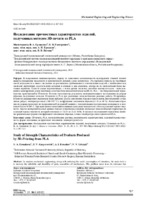| dc.contributor.author | Ермакова, В. А. | |
| dc.contributor.author | Гасперович, Е. В. | |
| dc.contributor.author | Ермаков, А. И. | |
| dc.contributor.author | Литвяк, В. В. | |
| dc.coverage.spatial | Минск | ru |
| dc.date.accessioned | 2022-04-06T13:00:03Z | |
| dc.date.available | 2022-04-06T13:00:03Z | |
| dc.date.issued | 2022 | |
| dc.identifier.citation | Исследование прочностных характеристик изделий, полученных методом 3D-печати из PLA = Study of Strength Characteristics of Products Produced by 3D-Printing from PLA / В. А. Ермакова [и др.] // Наука и техника. – 2022. – № 2. – С. 107-113. | ru |
| dc.identifier.uri | https://rep.bntu.by/handle/data/110960 | |
| dc.description.abstract | В современном машиностроении, наряду со снижением металлоемкости конструкций, главной задачей является повышение надежности и долговечности деталей, узлов механизмов. Эта проблема никогда не утрачивает своей актуальности в связи с постоянно возрастающими требованиями к изготовлению изделий, с необходимостью экономии дефицитных дорогостоящих металлов и сплавов и, как следствие, замены их на экономически более выгодные варианты. Один из самых перспективных, с точки зрения экологии, способов замены металлов – использование в конструкциях узлов пластиков, в частности полимолочной кислоты (PLA). PLA – это биоразлагаемый термопластик, применяемый в 3D-печати. В статье представлены результаты экспериментального исследования на разрыв образцов, полученных методом 3D-печати из PLA при различных технологических режимах работы 3D-принтера. В качестве варьируемых параметров были выбраны: форма заполнения образцов (треугольник, шестигранник (соты), линия, ребро), температура сопла (190–205 С), коэффициент заполнения образца (от 10 до 40 %). Испытания образцов на разрыв проводили на гидравлической разрывной машине с измерительным программным комплексом в комплекте Kason WDW-5. При выполнении испытаний основным выходным показателем считали условный предел текучести. Анализ экспериментальных данных показал существенное влияние изучаемых технологических параметров на условный предел текучести, который изменялся от 16,50 до 22,42 МПа. В процессе исследований определены наиболее рациональные формы и коэффициент заполнения образцов, а также температура сопла при печати PLA. | ru |
| dc.language.iso | ru | ru |
| dc.publisher | БНТУ | ru |
| dc.title | Исследование прочностных характеристик изделий, полученных методом 3D-печати из PLA | ru |
| dc.title.alternative | Study of Strength Characteristics of Products Produced by 3D-Printing from PLA | ru |
| dc.type | Article | ru |
| dc.identifier.doi | 10.21122/2227-1031-2022-21-2-107-113 | |
| local.description.annotation | In modern mechanical engineering, along with reducing the metal consumption of structures, the main task is to increase the reliability and durability of parts, assemblies of mechanisms. This problem never loses its relevance due to the ever-increasing requirements for manufacture of products, with the need to save scarce expensive metals and alloys and, as a result, replace them with economically more profitable options. One of the most promising, from the point of view of ecology, ways to replace metals, is to use in the construction of plastic assemblies, in particular polylactic acid (PLA). PLA is a biodegradable thermoplastic used in 3D-printing. The paper presents results of an experimental study on the rupture of samples obtained by 3D-printing from PLA under various technological operating modes of 3D-printer. The following parameters have been chosen as variable parameters: the form of filling samples (triangle, hexagon (honeycomb), line, edge), nozzle temperature (190–205 С), sample filling factor (from 10 up to 40 %). Tensile testing of the samples have been carried out on a hydraulic tensile machine with a measuring software package in the Kason WDW-5 set. When performing tests, the conditional yield strength was considered the main out put indicator. The analysis of experimental data has shown a significant effect of the investigated technological parameters on the conventional yield point, which varied from 16.5 to 22.42 MPa. The most rational forms and sample filling factor, as well as the temperature of nozzle when printing with PLA, have been determined. | ru |

